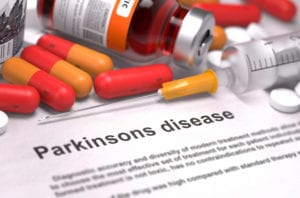Written by Jessica Patella, ND. Of the 73 participating patients with Parkinson’s disease, those who received 12-weeks of bee venom acupuncture experienced significant improvement of symptoms that lasted for 20 weeks while the symptoms of the sham acupuncture treatment group returned to baseline level.
 Parkinson’s disease is the second most common neurodegenerative disorder in the world and approximately 60,000 Americans are diagnosed each year 1-3. In the United States alone, Parkinson’s disease costs an estimated $25 billion each year 3. A recent study found that combined treatment of acupuncture and bee venom acupuncture might be a safe and effective adjunctive treatment for Parkinson’s disease 1.
Parkinson’s disease is the second most common neurodegenerative disorder in the world and approximately 60,000 Americans are diagnosed each year 1-3. In the United States alone, Parkinson’s disease costs an estimated $25 billion each year 3. A recent study found that combined treatment of acupuncture and bee venom acupuncture might be a safe and effective adjunctive treatment for Parkinson’s disease 1.
Parkinson’s disease is characterized by resting tremors, rigidity, bradykinesia, and postural instability 1,2. The most commonly used drug is a dopamine replacement, since dopamine levels are low in Parkinson’s disease, but the drug doesn’t slow the disease progression 1. For this reason many Parkinson’s patients turn to complementary alternative medicine 1,4.
Bee venom has been studied and found to have anti-inflammatory properties and protect dopamine in the brain 1,5. Previous research found that bee venom acupuncture improved symptoms of Parkinson’s disease 1,6.
The recent Korean double-blind, three-armed, randomized controlled clinical trial included 73 patients diagnosed with Parkinson’s disease who were randomly assigned to one of three groups:
- The Active Treatment Group: received bee venom acupuncture (BVA) and acupuncture: 0.1 mL bee venom diluted in saline injected into LI11 to test for venom allergy, then injected into the following 10 acupuncture points (bilateral GB20, LI11, GB34, ST36, LR3) (n=29)
- The Sham Treatment Group: received normal saline injection and sham acupuncture. 1 mL saline injected into LI11 for sham venom allergy testing, then injected into 10 sham acupuncture points. (n=29)
- Conventional Treatment Group: no additional intervention (n=15)
All groups maintained anti-parkinsonian drugs and those in the active and sham treatment groups underwent two 15-minute acupuncture treatments weekly for 12 weeks 1.
After 12 weeks of treatment, both the active and sham treatment groups showed significant improvements compared to baseline in the following measures: Parkinson’s Disease Quality of Life Questionnaire, Unified Parkinson’s Disease Rating scale part II (UPDRS activities of daily living) (p<0.001), UPDRS part III (motor) (p<0.008), number of steps to walk 20 meters (p<0.05), while the postural instability and gait disturbance (PIGD) score only showed significant change in the active treatment group (p<0.001) 1.
Twenty weeks after treatment had finished, participants were reassessed. Only those in the active treatment group showed significant lasting effects in the following measures: Parkinson’s Disease Quality of Life Questionnaire, Unified Parkinson’s Disease Rating scale part II (UPDRS activities of daily living), UPDRS part III (motor), number of steps to walk 20 meters, postural instability and gait disturbance (PIGD) score and Beck’s Depression Index 1.
The researchers suggest a possible placebo effect to account for lack of significant differences between the active and sham groups at the end of 12 weeks. Studies have shown that up to 50% of patients with PD experience placebo effects which are due to “the activation of a damaged nigrostriatal dopamine system and the release of dopamine in the striatum 7. In addition, physical placebo is considered to be even more powerful than oral placebo” 8,9. However, in spite of a possible placebo effect, the active treatment group had prolonged symptom relief for 20 weeks while the symptoms of the sham treatment group returned to baseline level.
In conclusion, combined treatment of acupuncture and bee venom acupuncture were shown to be a safe and effective treatment for Parkinson’s disease, with lasting effects. There were no serious events observed, although it is important to make sure that recipients are not allergic to bee venom. Future research should confirm these results with a larger study population.
Source: Cho, Seung-Yeon, Young-Eun Lee, Kyeong-Hee Doo, Ji-Hyun Lee, Woo-Sang Jung, Sang-Kwan Moon, Jung-Mi Park et al. “Efficacy of Combined Treatment with Acupuncture and Bee Venom Acupuncture As an Adjunctive Treatment for Parkinson’s Disease.” The Journal of Alternative and Complementary Medicine (2017).
© Mary Ann Liebert, Inc.
Posted December 18, 2017.
References:
- Cho S-Y, Lee Y-E, Doo K-H, et al. Efficacy of Combined Treatment with Acupuncture and Bee Venom Acupuncture As an Adjunctive Treatment for Parkinson’s Disease. The Journal of Alternative and Complementary Medicine. 2017.
- Jankovic J. Parkinson’s disease: clinical features and diagnosis. Journal of Neurology, Neurosurgery & Psychiatry. 2008;79(4):368-376.
- Foundation Ps. Understanding Parkinson’s: Statistics. 2017; Overview of Parkinson’s Disease. Available at: http://parkinson.org/Understanding-Parkinsons/Causes-and-Statistics/Statistics. Accessed November 9, 2011, 2017.
- Rajendran PR, Thompson RE, Reich SG. The use of alternative therapies by patients with Parkinson’s disease. Neurology. 2001;57(5):790-794.
- Kim J-I, Yang EJ, Lee MS, et al. Bee venom reduces neuroinflammation in the MPTP-induced model of Parkinson’s disease. International Journal of Neuroscience. 2011;121(4):209-217.
- Cho S-Y, Shim S-R, Rhee HY, et al. Effectiveness of acupuncture and bee venom acupuncture in idiopathic Parkinson’s disease. Parkinsonism & related disorders. 2012;18(8):948-952.
- De la Fuente-Fernández R, Ruth TJ, Sossi V, Schulzer M, Calne DB, Stoessl AJ. Expectation and dopamine release: mechanism of the placebo effect in Parkinson’s disease. Science. 2001;293(5532):1164-1166.
- de la Fuente-Fernández R, Schulzer M, Stoessl AJ. The placebo effect in neurological disorders. The Lancet Neurology. 2002;1(2):85-91.
- Kaptchuk TJ, Goldman P, Stone DA, Stason WB. Do medical devices have enhanced placebo effects? Journal of clinical epidemiology. 2000;53(8):786-792.

